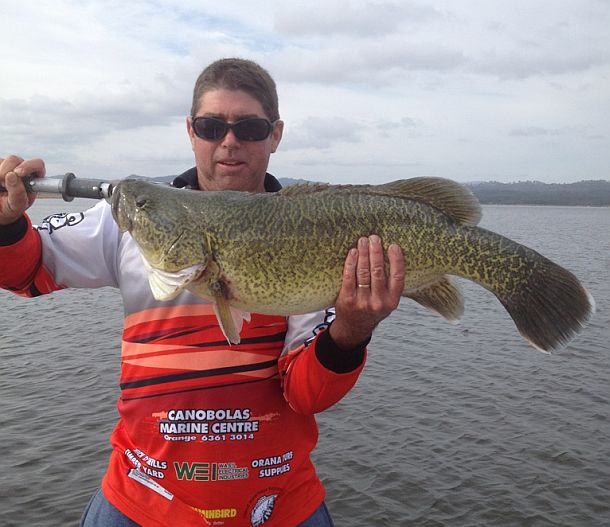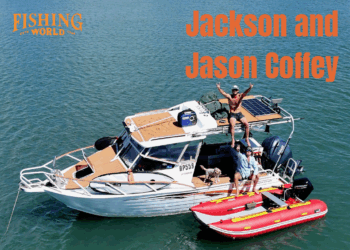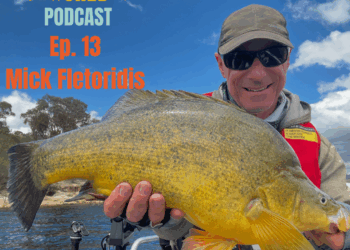IF, like me, you live on the coast, you tend to be unaware of how big fishing is out in the bush. So you can understand my surprise when I pulled into Lake Burrendong State Park last Friday afternoon and saw the hundreds of tinnies, tents and camper vans owned by anglers and their families fishing the annual Lake Burrendong Classic.
This is a big comp!
And Burrendong is a big impoundment. After meeting up with long-time Fisho writer Mark “Wilbur” Williams, we both signed up for the comp and then loaded all our camping and fishing gear into the Sea Jay and joined the queue at the ramp. It wasn’t long before we were out in the main basin motoring around looking for an island where our mates were camped.


There was no shortage of entrants and boats at this year’s comp. Images: Mark Williams
After initially heading in completely the wrong direction, we found the campsite, met the fellas, hastily unpacked the gear and hit the water, eager to check things out. Both Wilb and I really enjoy fishing new water – it’s always a challenge and being out of your comfort zones adds an interesting dimension to the experience. As the sun set, turning the standing trees a reddish brown and making the rocky banks glow a rich ochre, we trolled a few lures around likely points and snags. We both kept a close eye on the Humminbird side scanner, marking plenty of structure and more than a few fish.

Home away from home on an island out in the lake. Image: Jim Harnwell
We were back at the camp before sundown, drinking a cold beer in front of the fire as Ken Smith prepared fish and chips for a Good Friday dinner. Ken’s dad Jack, along with son-in-law Roy Wotton, had caught five solid yellowbelly in a snag. Skinned, filleted and dusted in flour, the fish came up a treat.
Camped with us were Ken’s mates Col Gordon and Bill Josh, both central west locals with long experience targeting native fish.
Next morning was Day 1 of the comp. Ken, Wilb and I set off with a bucket of live shrimp to work over a few snags. Burrendong is littered with standing trees, remnants of the forest that existed here before the dam’s construction in the 1950s. Many of the locals “bob” in the sticks for yellowbelly and introduced redfin with shrimp, yabbies or lures. It’s a simple but effective technique. Every tree I could seemed to have a boat tied up to it.

The lake features multitudes of dead trees where anglers bobbed shrimps and lures for golden perch and redfin. Image: Jim Harnwell
We found a likely clump of branches in about 80 feet of water and started fishing. After 15 minutes with no bites we moved to another snag. Ken had one solid take which missed the hook so we gave the tree more time. But the fish didn’t come out to play again. A change of tack was required. We put away the shrimp rigs and tied on deep diving lures. Wilb and I had spotted a couple of likely banks that looked the goods for a troll session during our exploratory mission the previous evening. I rigged up a Rapala Taildancer in “perch” colour while Ken and Wilb tied on bigger cod style lures. There were plenty of fish and structure in the 15-20 foot line and we worked the area twice before I connected to a reasonable fish. That 42cm yellowbelly, plus a couple of small redfin, was all we got. The fishing was very quiet, mainly because of a low-pressure system that was slowly moving across western NSW. Even the bobbers with their live shrimp failed to attract many bites.
 Image: Mark Williams
Image: Mark Williams
The only thing to do when the fishing is slow is to keep fishing. We elected to cover water by trolling and kept working rocky banks, drop-offs, points and edges. My big chance at glory came – and went – while trolling along a short but steep bank. As always seems to happen, I was at the transom taking a pee when the fish hit. The rod buckled over in the holder, line ripped off the drag in powerful bursts. I hastily rearranged the wedding tackle, grabbed the rod and loaded up on a solid fish. A couple of big headshakes and a short but unstoppable run and the 15lb braid came in contact with a rock. End of story. If my bladder had held on just 30 seconds more there was every chance I would have brought a reasonable Murray cod to the boat. The fish was way too powerful to have been a yellowbelly or silver perch. As it turned out, no one landed a cod all weekend …

Kevin Spears with a 570mm Burrendong golden perch that took out the 2013 Canobolas Marine Lake Burrendong Classic.
Slow fishing aside, it was a great comp. The Lake Burrendong Classic, organised by Dubbo local Matt Hansen and his team at the Inland Waters Rejuvenation Association, is a C&R event aimed at both serious anglers and the family fisho. Plenty of cabins and camping options are available at the park but you can camp anywhere along the lake’s shoreline. Ken found us a private island about five minutes cruise away from the ramp – it was great to pull the boat up on the bank, unroll the swags, get a fire going and relax. A few lines baited with live shrimp resulted in catfish and carp being hooked.
Burrendong, located near Wellington in the central west, is a fair drive from the coast. It took six hours for me to get there from my home base near Jervis Bay and a similar time for Wilb driving from the Central Coast. But it’s a pretty easy journey and the landscape and fishing is totally different to that on the coast. Being free to set up camp where you like and the diversity of fishing – bait, lure, fly, spin, troll – for prized natives such as Murray cod, yellowbelly, silvers and catfish, plus unwanted imports such as redfin and some XOS carp, make this a pretty interesting fishery.
With a good high-pressure system overhead, there’s little doubt that this place would go off. I’ll be hoping for a rising barometer when I head out west again for the 2014 Lake Burrendong Classic.
For full results of the 2013 event, click HERE.




















